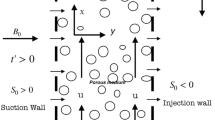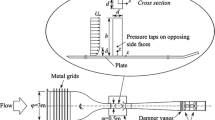Abstract
Flow and acoustic fields of a rectangular over-expanded supersonic jet interacting with an adjacent parallel plate are investigated using compressible Large Eddy Simulations (LES). The jet exits from a converging diverging rectangular nozzle of aspect ratio 2 with a design Mach number 1.5. Four distances (0 to 3 equivalent diameters) between the plate and the adjacent lip of the rectangular jet in the minor axis plane are studied. The geometry of the nozzle, the positions of the plate, and the exit conditions are identical to the ones of an experimental study. Snapshots and mean velocity fields are presented. Good agreement with the PIV experimental measurements is obtained. Previously, the corresponding free jet has been found to undergo a strong flapping motion in the minor axis plane due to screech. Here, it is shown that the intensity of the screech increases for certain distances from the plate and decreases for others, as compared to the corresponding free jet. Two points space-time cross correlations of the pressure along the jet’s shear-layers show, in two cases, an amplification of the aeroacoustic feedback mechanism leading to screech noise in the jet shear-layer closer to the plate. This amplification is due to acoustic waves impinging on the plate, and generating propagating waves back towards the jet, thus exciting the shear-layer at the screech frequency, around the tenth shock cell. Moreover, when the jet develops as a wall jet on the plate, the screech frequency and its associated flapping motion is canceled but a symmetrical oscillation of the jet at a lower frequency becomes dominant and radiates in the near acoustic field. This oscillation mode, as the ones associated with the screech tones for the other cases studied, can be explained by the use of a vortex sheet model of the ideally expanded equivalent planar jet.


















Similar content being viewed by others
Abbreviations
- \(\delta _{0.5}\) :
-
Half velocity width of the jet (m)
- \(\theta\) :
-
Angle of observation (degrees)
- \(\mu _j\) :
-
Viscosity in the ideally expanded jet, computed using Sutherland’s Law (\(kg\,(m\,s)^{-1}\))
- \(\nu _j = \mu _j/\rho _j\) :
-
Kinematic viscosity in the ideally expanded jet (\(m^2\,s^{-1}\))
- \(\omega\) :
-
Frequency (\(rad\,s^{-1}\))
- \(\rho _j\) :
-
Density in the ideally expanded equivalent jet (\(kg\,m^{-3}\))
- \(a_0\) :
-
Speed of sound in the ambient (\(m\,s^{-1}\))
- \(a_j\) :
-
Speed of sound in the ideally expanded equivalent jet (\(m\,s^{-1}\))
- \(A_d=2h \times h\) :
-
Exit area of the nozzle (\(m^2\))
- \(A_j\) :
-
Exit area of the ideally expanded equivalent nozzle (\(m^2\))
- b :
-
Depth of the nozzle (m)
- \(b_j\) :
-
Depth of the ideally expanded equivalent nozzle (m)
- \(D_{eq} = \sqrt{8/\pi } \times h\) :
-
Equivalent diameter of the jet (m)
- f :
-
Frequency (Hz)
- h :
-
Height of the nozzle (m)
- \(h_j\) :
-
Height of the ideally expanded equivalent nozzle (m)
- k :
-
Wavenumber (\(rad\,m^{-1}\))
- \(L_n\) :
-
Length of the n-th shock cell (m)
- \(L_s\) :
-
Length of the first shock cell (m)
- \(L_{sh}\) :
-
Length scale related to the shock cell size (m)
- \({\mathcal {M}}_c\) :
-
Convective Mach number
- \({\mathcal {M}}_d\) :
-
Design Mach number of the jet
- \({\mathcal {M}}_j\) :
-
Mach number of the ideally expanded equivalent jet
- n :
-
Mode number of the oscillation mode of the planar jet
- \(u_c\) :
-
Convection velocity (m/s)
- \(u_j\) :
-
Velocity of the ideally expanded equivalent jet (m/s)
- \(St = fD_{eq}/u_j\) :
-
Strouhal number based on \(D_{eq}\)
- \(St_{hj} = fh_j/u_j\) :
-
Strouhal number based on \(h_j\)
- x :
-
Coordinate along the major axis of the nozzle (m)
- y :
-
Coordinate along the minor axis of the nozzle (m)
- z :
-
Coordinate along the jet axis (m)
References
André, B.: Etude expérimentale de l’effet du vol sur le bruit de choc de jets supersoniques sous-détendus. PhD thesis, Ecole Centrale de Lyon (2012). 2012–42
Bogey, C., Bailly, C.: An analysis of the correlations between the turbulent flow and the sound pressure fields of subsonic jets. J. Fluid Mech. 583, 71–97 (2007). https://doi.org/10.1017/S002211200700612X
Bogey, C., Gojon, R.: Feedback loop and upwind-propagating waves in ideally expanded supersonic impinging round jets. J. Fluid Mech. 823, 562–591 (2017). https://doi.org/10.1017/jfm.2017.334
Bridges, J.E.: Noise from aft deck exhaust nozzles–differences in experimental embodiments. AIAA Paper 2014-0876 (2014). https://doi.org/10.2514/6.2014-0876
Brown, C.A., Clem, M.M., Fagan, A.F.: Investigation of broadband shock noise from a jet near a planar surface. J. Aircr. 52(1), 266–273 (2014). https://doi.org/10.2514/1.C032695
Chen, S., Gojon, R., Mihaescu, M.: Flow and aeroacoustic attributes of highly-heated transitional rectangular supersonic jets. Aerosp. Sci. Technol. 114, 106747 (2021). https://doi.org/10.1016/j.ast.2021.106747
Dahl, M.D.: Predictions of supersonic jet mixing and shock-associated noise compared with measured far-field data. NASA Technical Report TM-2010-216328 (2010)
Davies, M.G., Oldfield, D.E.S.: Tones from a choked axisymmetric jet. ıı. the self excited loop and mode of oscillation. Acta Acust. Acust. 12, 267–277 (1962)
Ducros, F., Ferrand, V., Nicoud, F., Weber, C., Darracq, D., Gacherieu, C., Poinsot, T.: Large-eddy simulation of the shock/turbulence interaction. J. Comput. Phys. 152(2), 517–549 (1999). https://doi.org/10.1006/jcph.1999.6238
Edgington-Mitchell, D., Jaunet, V., Jordan, P., Towne, A., Soria, J., Honnery, D.: Upstream-travelling acoustic jet modes as a closure mechanism for screech. J. Fluid Mech. 855 (2018)
Eliasson, P.: EDGE: A Navier-Stokes Solver for Unstructured Grids, (2001)
Gojon, R., Baier, F., Gutmark, E.J., Mihaescu, M.: Temperature effects on the aerodynamic and acoustic fields of a rectangular supersonic jet. AIAA Paper 2017-0002 (2017). https://doi.org/10.2514/6.2017-0002
Gojon, R., Bogey, C., Mihaescu, M.: Oscillation modes in screeching jets. AIAA J. 56(7), 2918–2924 (2018). https://doi.org/10.2514/1.J056936
Gojon, R., Gutmark, E., Mihaescu, M.: Antisymmetric oscillation modes in rectangular screeching jets. AIAA J. 57(8), 3422–3441 (2019)
Gojon, R., Bogey, C.: Flow structure oscillations and tone production in underexpanded impinging round jets. AIAA J. 55(6), 1792–1805 (2017b). https://doi.org/10.2514/1.J055618
Gojon, R., Bogey, C., Marsden, O.: Investigation of tone generation in ideally expanded supersonic planar impinging jets using large-eddy simulation. J. Fluid Mech. 808, 90–115 (2016). https://doi.org/10.1017/jfm.2016.628
Gojon, R., Bogey, C.: Numerical study of the flow and the near acoustic fields of an underexpanded round free jet generating two screech tones. International Journal of Aeroacoustics, to appear; see also AIAA Paper 2015-2210 (2017a). https://doi.org/10.1177/1475472X17727606
Gutmark, E., Schadow, K.C.: Flow characteristics of orifice and tapered jets. Phys. Fluids 30(11), 3448–3454 (1987). https://doi.org/10.1063/1.866477
Hsia, Y., Krothapalli, A., Baganoff, D., Karamcheti, K.: Effects of mach number on the development of a subsonic rectangular jet. AIAA J. 21(2), 176–177 (1983). https://doi.org/10.2514/3.8050
Krothapalli, A., Baganoff, D., Karamcheti, K.: On the mixing of a rectangular jet. J. Fluid Mech. 107, 201–220 (1981). https://doi.org/10.1017/S0022112081001730
Liu, J., Corrigan, A., Kailasanath, K., Ramamurti, R., Heeb, N., Munday, D., Gutmark, E.J.: Impact of deck and jet blast deflector on the flow and acoustic properties of an imperfectly expanded supersonic jet. Nav. Eng. J. 127(3), 47–60 (2015)
McLaughlin, D., Kno, C.W., Papamoschou, D.: Experiments on the effect of ground reflections on supersonic jet noise. AIAA Paper 2008-0022 (2008). https://doi.org/10.2514/6.2008-22
Merle, M.: Sur la fréquence des ondes sonores émises par un jet d’air à grande vitesse. Comptes-Rendus de l’Académie des Sciences de Paris 243, 490–493 (1956)
Mora, P., Baier, F., Kailasanath, K., Gutmark, E.J.: Acoustics from a rectangular supersonic nozzle exhausting over a flat surface. J. Acoustical Soc. Am. 140(6), 4130–4141 (2016). https://doi.org/10.1121/1.4967158
Nichols, J.W., Lele, S.K.: Large eddy simulation of crackle noise in hot supersonic jets. J. Acoustical Soc. Am. 134(5), 4128–4138 (2013). https://doi.org/10.1121/1.4831161
Nogueira, P.A., Beekman, J., Weightman, J., Edgington-Mitchell, D.M.: On the waves underpinning screech in rectangular jets. In: AIAA AVIATION 2023 Forum, p. 4488 (2023)
Panda, J., Seasholtz, R.G.: Experimental investigation of density fluctuations in high-speed jets and correlation with generated noise. J. Fluid Mech. 450, 97–130 (2002). https://doi.org/10.1017/S002211200100622X
Powell, A.: On the mechanism of choked jet noise. Proc. Phys. Soc. Lond., Sect. B 66(12), 1039–1056 (1953)
Panda, J.: An experimental investigation of screech noise generation. J. Fluid Mech. 378, 71–96 (1999). https://doi.org/10.1017/S0022112098003383
Powers, R.W., McLaughlin, D.K., Morris, P.J.: Noise reduction with fluidic inserts in supersonic jets exhausting over a simulated aircraft carrier deck. AIAA Paper 2015-2374 (2015). https://doi.org/10.2514/6.2015-2374
Panda, J., Raman, G., Zaman, K.B.M.Q.: Underexpanded screeching jets from circular, rectangular and elliptic nozzles. AIAA Paper 97-1623 (1997). https://doi.org/10.2514/6.1997-1623
Sandham, N.D., Salgado, A.M.: Nonlinear interaction model of subsonic jet noise. Philos. Transact. Royal Soc. Lond. A Math., Phys. Eng. Sci. 366(1876), 2745–2760 (2008). https://doi.org/10.1098/rsta.2008.0049
Shen, H., Tam, C.K.W.: Three-dimensional numerical simulation of the jet screech phenomenon. AIAA J. 40(1), 33–41 (2002). https://doi.org/10.2514/2.1638
Tam, C.K.W.: Mach wave radiation from high-speed jets. AIAA J. 47(10), 2440–2448 (2009). https://doi.org/10.2514/1.42644
Tam, C.K.W., Tanna, H.K.: Shock associated noise of supersonic jets from convergent-divergent nozzles. J. Sound Vib. 81(3), 337–358 (1982). https://doi.org/10.1016/0022-460X(82)90244-9
Tam, C.K.W., Norum, T.D.: Impingement tones of large aspect ratio supersonic rectangular jets. AIAA J. 30(2), 304–311 (1992)
Tam, C.K.W., Hu, F.Q.: On the three families of instability waves of high-speed jets. J. Fluid Mech. 201, 447–483 (1989)
Tam, C.K.W., Seiner, J.M., Yu, J.C.: Proposed relationship between broadband shock associated noise and screech tones. J. Sound Vib. 110(2), 309–321 (1986). https://doi.org/10.1016/S0022-460X(86)80212-7
Towne, A., Cavalieri, A.V.G., Jordan, P., Colonius, T., Schmidt, O., Jaunet, V., Brès, G.: Acoustic resonance in the potential core of subsonic jets. J. Fluid Mech. 825, 1113–1152 (2017). https://doi.org/10.1017/jfm.2017.346
Westley, R., Woolley, J.H.: The near field sound pressures of a choked jet during a screech cycle. AGARD Conf. Proc. 42, 23–12313 (1969)
Yu, J.C., Tam, C.K.W.: Experimental investigation of the trailing edge noise mechanism. AIAA J. 16(10), 1046–1052 (1978). https://doi.org/10.2514/3.61003
Zaman, K.B.M.Q., Fagan, A.F., Clem, M.M., Brown, C.A.: Resonant interaction of a rectangular jet with a flat-plate. AIAA Paper 2014-0877 (2014). https://doi.org/10.2514/6.2014-0877
Zaman, K., Fagan, A., Bridges, J., Brown, C.: An experimental investigation of resonant interaction of a rectangular jet with a flat plate. J. Fluid Mech. 779, 751–775 (2015)
Zaman, K.B.M.Q.: Axis switching and spreading of an asymmetric jet: the role of coherent structure dynamics. J. Fluid Mech. 316, 1–27 (1996). https://doi.org/10.1017/S0022112096000420
Funding
The computations were performed using HPC resources provided by the Swedish National Infrastructure for Computing (SNIC) at the PDC center, by GENCI [CCRT-CINES-IDRIS] (Grant 2021-[A0102A07178]), and by CALMIP (Project 1425-21A). Professor Ephraim Gutmark and Dr. Florian Baier at University of Cincinnati are acknowledged for providing the experimental data used in this paper.
Author information
Authors and Affiliations
Contributions
RG: Writing, Methodology, Software; MM: Conceptualization, Writing (review and editing).
Corresponding author
Ethics declarations
Conflict of interest
The authors declare no conflict of interest.
Informed consent
Non applicable to the present paper.
Supplementary Information
Below is the link to the electronic supplementary material.
Supplementary file 1 (m4v 9476 KB)
Supplementary file 2 (m4v 5411 KB)
Supplementary file 3 (m4v 3186 KB)
Supplementary file 4 (m4v 2738 KB)
Rights and permissions
Springer Nature or its licensor (e.g. a society or other partner) holds exclusive rights to this article under a publishing agreement with the author(s) or other rightsholder(s); author self-archiving of the accepted manuscript version of this article is solely governed by the terms of such publishing agreement and applicable law.
About this article
Cite this article
Gojon, R., Mihaescu, M. Impact of an Adjacent Surface on a Rectangular Overexpanded Supersonic Jet. Flow Turbulence Combust (2023). https://doi.org/10.1007/s10494-023-00505-3
Received:
Accepted:
Published:
DOI: https://doi.org/10.1007/s10494-023-00505-3




